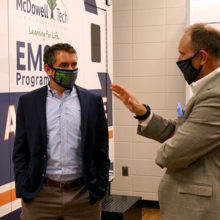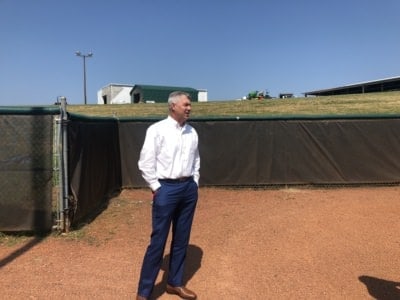This is a copy of the Awake58 newsletter originally sent on Monday, September 17, 2018. Click here to subscribe.
Welcome to Awake58!
Hi, it’s Nation. Thank you for reading Awake58 and EdNC.org. We hope that this edition finds you safe and sound in the aftermath of Hurricane Florence. This week we highlight some of your answers on working second jobs, a visit with President Maria Pharr of South Piedmont Community College, and a photography program at Randolph Community College.
We have been tracking the impact of Hurricane Florence over recent days. It has been heartbreaking to see so many communities devastated. We remain worried about the impacts which may yet unfold. Please know our thoughts are with all of you. We know the real challenge for many families and communities will begin when the cameras and reporters go home.
This week Bryan Noreen and I traveled to the Tyson Family Center for Technology to learn more about South Piedmont Community College (SPCC). Dr. Maria Pharr and her staff welcomed us by showcasing their apprenticeship programs prior to walking us through their vision for the college over lunch.
Here are two key takeaways:
- Dr. Pharr feels that community colleges are the most effective option for students who choose to seek post-secondary education. “Community colleges provide a high quality education for the first two years of a baccalaureate degree, offer students an avenue to explore options which may include relevant training for high-demand, gainful employment, and receive more hands-on and personal attention throughout the college experience without incurring substantial debt.” Communicating and marketing this value is difficult, as community colleges rarely have the financial resources to get this message out.
- Dr. Pharr believes part of the SPCC secret sauce is, “a lack of organizational silos.” The college is attempting to break down barriers between administrative structures that typically exist between our credit bearing and non-credit bearing programs. “When a student comes to us with a goal, we want them to have a seamless experience in entering the most applicable program to meet their short- and long-term goals.”
I would be curious to know more about any work going on within your campus to break down silos — just reply to this email.
And, finally, a special thank you to the many faculty who wrote in to share their experiences working second jobs. I’ve shared some of your comments below.
Join us on October 8th
We will be at the NC Community College System Conference in October. Will you? We will have a table at the conference and we hope you will say hi, but we also have something cool to announce.
We invite you to be our guest for a reception the evening of October 8th at Marbles Kids Museum in downtown Raleigh featuring Sam Jones BBQ, additional food, drinks, and live music. The event will begin at 6:00 p.m.
This event is made possible by the generous sponsorship of the John M Belk Endowment. The event is free, but space is limited so RSVP today by clicking here.
EdNC Picks
Randolph Community College on the cutting edge of photography
“Vermont native Nathan Burton knew he wanted to pursue photography as a career after high school. He and his dad decided to tour some of the best schools in the country to find the right fit.”
And then he found Randolph Community College. He shares in the piece, “I was at first super skeptical … how could a community college have something that was greater?”
Changing misconceptions of manufacturing at Blue Ridge Community College
Blue Ridge Community College President Laura Leatherwood tells Analisa Sorrells, “We are embedding ourselves in our schools, but we are also embedding ourselves in our companies, and when you can match that together, then you’re preparing a next-generation workforce.”
Other EdNC reads
Lessons on leadership and the future of community colleges from Catawba Valley Community College
Pitt Community College is flying into the future
A focus on student success at Gaston College
Articles worth your time
In The Weeks Before Freshman Year, Money Worries Aplenty
NPR visits a college advisor’s office in this piece: Many of the students who shuffle into her office ended the school year in celebration. They’re going to college! The schools they’ve picked were pinned up on bulletin boards in the hall; some students even made the local news. And then summer rolls around, bringing with it one big question: Can I actually afford this?
Today’s College Students Aren’t Who You Think They Are
Another great piece from NPR. This new series explores the “new normal” of college students and intends to raise ideas on how we might support them. Key excerpt: “Perhaps that means offering services like financial aid, advising or tutoring after-hours (instead of the typical 9 to 5). Maybe it means offering child care for student-parents, or extra parking for commuters.”
We asked. You answered.
Each week we pose a few quick questions to a North Carolina leader who is involved with education. This week, we spoke with Sharon Lauffer from Southwestern Community College. Sharon wrote in response to our request for information around working second jobs while serving on faculty.
- What led you to teaching within the community college system?
Sharon Lauffer: I love the opportunity to teach and positively impact the lives of students. I was ready to leave the traditional workplace and make a change that was more fulfilling, and that provided me with the opportunity to use my education and years of experience to affect others. The schedule also has a degree of flexibility which works well for me, personally.
- You have said you have a second job. Where do you work?
SL: I teach online, as needed, at Western Carolina University.
- Is the second job a financial necessity?
SL: Yes.
- What is your favorite part of teaching within a community college?
SL: I love the students. I teach a diverse group, from early college students all the way up to grandparents. Some of my students have degrees, have jobs, and have families, while others are just getting started in life. I love the diversity, the supportive culture of community college, and the fact that I get to see so many students work hard and succeed.
In addition to Sharon, we heard from several other folks.
Michael told us, “I am a staff member who has to work a second job to get by each month to help support my family of five. I put in about 70 hours a week plus grad school. I have been in the community college system for 13 years.”
Larry shared, “I work an ‘as-needed job’ on the side, but if my wife did not work, we could not make it. I am 68, she is 69, and we do not see retirement in our future.”
This journey seems to be a common one. We would love to hear your story. Just reply directly to this email.
By the numbers
$36,844 for faculty
The minimum salary for a full-time faculty member in the North Carolina Community College system.
$139,254 for presidents
The minimum pay for community college presidents, which can range up to $158,718.
$4,069 increase
In the last 10 years, the average community college curriculum faculty salary has increased $4,069 in real dollars. For 2017-2018, the average is $50,293.
Johnston Community College tops the system
At an average of $58,440, Johnston has the best pay in the system for its 109 full-time employees, followed by Southeastern and Robeson.
One more thing
We were grateful to meet faculty at South Piedmont Community College — including Michael Scott who is the program lead for Welding Tech.




